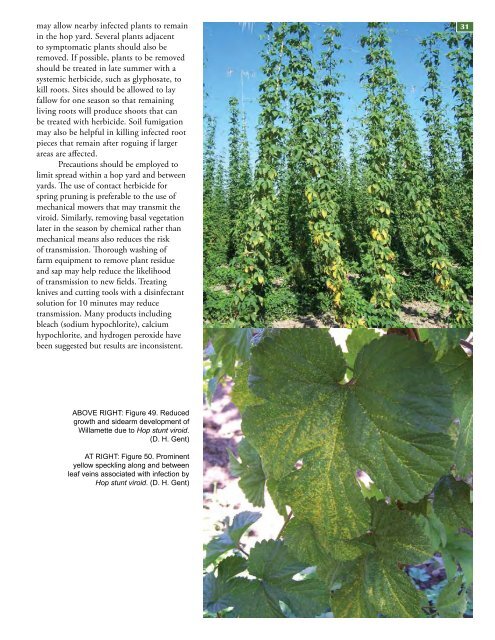Field Guide for Integrated Pest Management in Hops
Field Guide for Integrated Pest Management in Hops
Field Guide for Integrated Pest Management in Hops
Create successful ePaper yourself
Turn your PDF publications into a flip-book with our unique Google optimized e-Paper software.
may allow nearby <strong>in</strong>fected plants to rema<strong>in</strong><strong>in</strong> the hop yard. Several plants adjacentto symptomatic plants should also beremoved. If possible, plants to be removedshould be treated <strong>in</strong> late summer with asystemic herbicide, such as glyphosate, tokill roots. Sites should be allowed to layfallow <strong>for</strong> one season so that rema<strong>in</strong><strong>in</strong>gliv<strong>in</strong>g roots will produce shoots that canbe treated with herbicide. Soil fumigationmay also be helpful <strong>in</strong> kill<strong>in</strong>g <strong>in</strong>fected rootpieces that rema<strong>in</strong> after rogu<strong>in</strong>g if largerareas are affected.Precautions should be employed tolimit spread with<strong>in</strong> a hop yard and betweenyards. The use of contact herbicide <strong>for</strong>spr<strong>in</strong>g prun<strong>in</strong>g is preferable to the use ofmechanical mowers that may transmit theviroid. Similarly, remov<strong>in</strong>g basal vegetationlater <strong>in</strong> the season by chemical rather thanmechanical means also reduces the riskof transmission. Thorough wash<strong>in</strong>g offarm equipment to remove plant residueand sap may help reduce the likelihoodof transmission to new fields. Treat<strong>in</strong>gknives and cutt<strong>in</strong>g tools with a dis<strong>in</strong>fectantsolution <strong>for</strong> 10 m<strong>in</strong>utes may reducetransmission. Many products <strong>in</strong>clud<strong>in</strong>gbleach (sodium hypochlorite), calciumhypochlorite, and hydrogen peroxide havebeen suggested but results are <strong>in</strong>consistent.31ABOVE RIGHT: Figure 49. Reducedgrowth and sidearm development ofWillamette due to Hop stunt viroid.(D. H. Gent)AT RIGHT: Figure 50. Prom<strong>in</strong>entyellow speckl<strong>in</strong>g along and betweenleaf ve<strong>in</strong>s associated with <strong>in</strong>fection byHop stunt viroid. (D. H. Gent)








